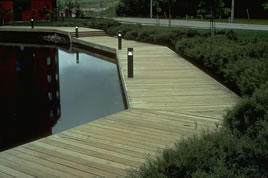Treated wood
Product description
Treated wood is lumber, timbers or round poles that have been treated with a chemical preservative to prolong their service life in cases where they do not have sufficient natural resistance to certain in-use conditions.

Larger image [76 kb JPG]
The treatment can render the wood useless as a food substance for insects such as termites and fungi (rot), while keeping the wood attractive by reducing the negative effects of weathering.
Some applications of treated wood include:
- decks and fences
- preserved wood foundations
- railway ties
- utility poles
- docks
- playground equipment
- landscaping
Technical information
A range of chemicals are used as wood preservatives. Since the chemicals are meant to be toxic to fungus and insects, they can pose health and environmental risks. Some chemicals that were common 20 years ago have been replaced by less toxic chemicals [e.g., ammoniacal copper quaternary (ACQ)].
Since the entire piece of wood, from the exterior to the core, needs protection, an effective wood preservative must have the ability to penetrate the wood, neutralize the food supply of fungi and insects, and be present in sufficient quantities in a non-leachable form. The preservatives are usually introduced into the wood during a pressure treatment process, creating a chemical envelope. It is sometimes necessary to create tiny slits into the surface of the wood (called incising) before the chemical treatment to increase the uptake of the liquid preservative.
Acid salts in general can reduce the strength of wood if they are present in large concentrations. However, the concentrations used in preservative-treated wood are often sufficiently small so that they do not affect the strength properties under normal use conditions.
The service life of treated wood products will depend on the type of chemical used, its uptake in the wood and the severity of the exposure conditions. Because of the inherent toxic nature of some chemicals used, it is important to minimize any leaching into the environment over the life of the product.
Page details
- Date modified: